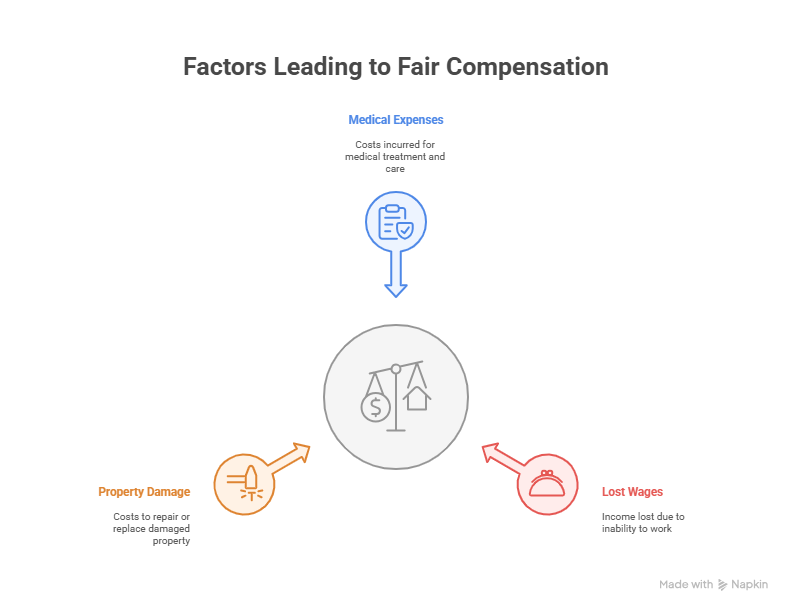Every year, millions of Americans are injured due to someone else’s negligence, with over 400,000 personal injury cases, being filed in the United States. If you’re one of them, navigating the complex legal system can be daunting.
Understanding the steps involved in a lawsuit can empower you to take control of your case. This guide will walk you through the key stages of the lawsuit process, from initial filing to final resolution.
By breaking down the personal injury lawsuit process into manageable steps, we aim to make the experience less intimidating and more manageable.
Understanding Personal Injury Claims
Personal injury claims are legal disputes that arise when an individual suffers harm due to another’s negligence or wrongdoing. These claims are designed to provide financial compensation to the injured party for their losses, including medical expenses, lost wages, and pain and suffering.
Common Types of Personal Injury Cases
Personal injury cases can stem from various incidents. Some of the most common include:
- Car accidents, where victims may suffer from whiplash, broken bones, or more severe injuries.
- Slip and fall incidents, often resulting from hazardous conditions on someone else’s property.
- Medical malpractice, where healthcare professionals fail to provide the standard of care, leading to patient harm.
These cases highlight the importance of understanding the legal process for personal injury claims.
Important Deadlines: Statute of Limitations
A critical aspect of filing a personal injury claim is being aware of the statute of limitations, the legal deadline by which a claim must be filed. This timeframe varies by state and type of claim, making it essential to consult with a legal professional promptly to avoid missing this crucial window.
Determining If You Have a Valid Claim
To have a valid personal injury claim, one must typically prove that their injuries resulted from another’s negligence or wrongful act. This involves demonstrating that the defendant had a duty of care, breached that duty, and that this breach directly caused the plaintiff’s injuries. Documenting evidence and seeking legal counsel are key steps in this process.
Understanding the timeline for a personal injury case and the legal process involved can significantly impact the outcome of a claim. By knowing what to expect and how to navigate the system, individuals can better advocate for themselves and secure the compensation they deserve.
The Personal Injury Lawsuit Process: Initial Steps
Understanding the initial steps in the personal injury lawsuit process can help you prepare for what’s ahead. When you’ve been injured due to someone else’s negligence, it’s crucial to know how to navigate the legal system effectively.
Seeking Immediate Medical Treatment
The first step after an injury is to seek medical attention. This is not only vital for your health but also for creating a medical record that can serve as crucial evidence in your case. Immediate medical treatment , helps establish a direct link between the accident and your injuries.
Documenting Your Injuries and Damages
Documenting every aspect of your injuries and the damages you’ve incurred is essential. This includes keeping detailed records of medical expenses, lost wages, and any other related costs. Thorough documentation will strengthen your claim and help in achieving a fair compensation.
| Type of Damage | Description | Example |
|---|---|---|
| Medical Expenses | Costs associated with medical treatment | Hospital bills, medication, rehabilitation |
| Lost Wages | Income lost due to inability to work | Salary, bonuses, other benefits |
| Property Damage | Damage to personal property | Vehicle repairs, replacement of damaged items |

Consulting with a Personal Injury Attorney
Consulting with a personal injury attorney can provide you with the legal guidance needed to navigate the complexities of your case. They can help you understand your rights and the potential value of your claim.
Filing the Official Complaint
The final initial step is filing the official complaint, which formally begins the lawsuit. This legal document outlines your claims against the defendant and is a critical step in the personal injury lawsuit process.
By following these initial steps, you can lay a solid foundation for your personal injury lawsuit. Understanding how to file a personal injury lawsuit, and being aware of the personal injury lawsuit stages can significantly impact the outcome of your case.
Navigating the Legal Proceedings After Filing
Filing a personal injury lawsuit is just the first step in a potentially lengthy legal process. After the initial filing, the case enters a series of legal proceedings that can be complex and challenging to navigate.
What to Expect During the Discovery Phase
The discovery phase is a critical part of the personal injury lawsuit process. During this phase, both parties exchange information and evidence related to the case. This can include document production, where relevant documents are shared, and depositions, where witnesses and parties involved are questioned under oath.
The discovery phase allows both sides to gather the necessary evidence to build their case. It’s a crucial step that can significantly impact the outcome of the lawsuit.
Participating in Settlement Negotiations
Many personal injury lawsuits are resolved through settlement negotiations before they go to trial. During these negotiations, both parties discuss potential settlement terms, aiming to reach a mutually acceptable agreement. Settlement negotiations can occur at various stages of the lawsuit process.
A successful settlement can save time and reduce the stress associated with going to trial. However, it’s essential to have a skilled personal injury attorney to negotiate on your behalf.
Preparing Your Case for Trial
If a settlement cannot be reached, the case will proceed to trial. Preparing for trial involves gathering and organizing evidence, identifying and preparing witnesses, and developing a compelling argument to present to the court.
Your personal injury attorney will play a crucial role in this preparation, ensuring that your case is presented effectively.
Understanding the Trial and Verdict Process
The trial is where both parties present their cases to a judge or jury. The plaintiff (you) will present your case first, followed by the defendant. After both sides have presented their arguments, the jury will deliberate and reach a verdict.
The verdict will determine whether the defendant is liable for your injuries and, if so, the amount of compensation you will receive. Understanding the trial and verdict process can help you prepare for the potential outcomes of your lawsuit.
Conclusion
Filing a personal injury lawsuit can be a complex and daunting process, but understanding the steps involved can help you navigate it more effectively. By following this personal injury lawsuit guide, you’ve learned about the initial steps, from seeking medical treatment to filing the official complaint, and the subsequent legal proceedings, including the discovery phase, settlement negotiations, and trial.
The steps in a personal injury lawsuit are designed to help you build a strong case and achieve the compensation you deserve. It’s essential to work with a personal injury attorney who can guide you through these steps and represent your interests in court.
While the process can be challenging, having a clear understanding of what to expect can make a significant difference. By being informed and prepared, you can confidently move forward with your claim and work towards a successful outcome.
FAQ
What is the typical timeline for a personal injury case?
The length of time it takes to resolve a personal injury case can vary significantly depending on factors such as the complexity of the case, the severity of the injuries, and the court’s schedule. Generally, it can take anywhere from several months to a few years.
How do I file a personal injury lawsuit?
To file a personal injury lawsuit, you will need to consult with a personal injury attorney who can guide you through the process. They will help you prepare and file the official complaint, which initiates the lawsuit.
What are the stages of a personal injury lawsuit?
The stages of a personal injury lawsuit typically include seeking medical treatment, documenting injuries and damages, consulting with an attorney, filing the complaint, discovery phase, settlement negotiations, preparing for trial, and the trial and verdict process.
What is the statute of limitations for personal injury claims?
The statute of limitations for personal injury claims varies by state, but it typically ranges from one to three years. It’s essential to consult with an attorney to determine the specific deadline for your case.
How is negligence determined in a personal injury case?
Negligence is determined by examining whether the defendant had a duty of care, breached that duty, and caused the plaintiff’s injuries as a result. Your personal injury attorney can help you understand how negligence applies to your case.
What can I expect during the discovery phase of my personal injury lawsuit?
During the discovery phase, both parties will exchange information and evidence, which may include depositions, interrogatories, and requests for production of documents. This phase helps both sides prepare for trial.
Can I settle my personal injury case out of court?
Yes, many personal injury cases are settled out of court through settlement negotiations. Your attorney can help you navigate these negotiations to reach a fair settlement.
What happens if my personal injury case goes to trial?
If your case goes to trial, both sides will present evidence and testimony to a jury, who will then reach a verdict. Your attorney will guide you through the trial process and help you understand what to expect.

